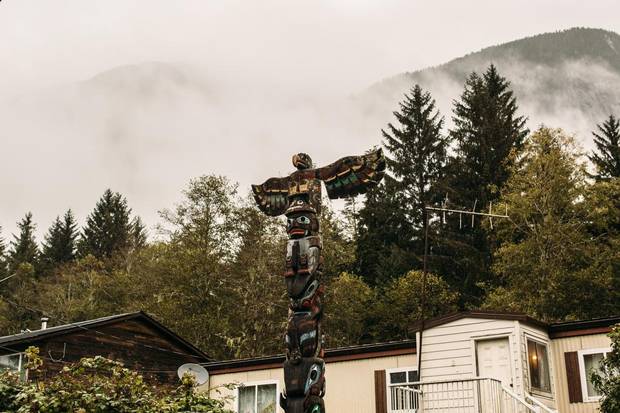A tray of glistening, rosy-pink eggs, with tiny black eyes peeping out of each sphere, holds an investment by the Wuikinuxv Nation in their future.
The Chinook salmon roe are being raised in a hatchery built and run by this small Indigenous community located on one of the most isolated stretches of British Columbia's coast.
The abundant marine life in Rivers Inlet sustained communities for millennia. But today, there are just 60 people left in the village on the banks of the Wannock River.
Ian Brown: Factions and tears in the Arctic aboard the C3 as Southerners confront their own battles with reconciliation
Margaret Wente: The Arctic will grip and change you
Related: How ships and climate change are bringing strange species to Nunavut
For one wet, rainforest-y day in October, the Canada C3 expedition – a 150-day sailing journey connecting coastal communities from Toronto to Victoria via the Northwest Passage to mark Canada's 150 th anniversary of Confederation – doubled the community's population. The invitation to the expedition members was extended with some hesitation: Canada's birthday, here, represents a history of oppression – of rights and title denied, of a rich culture suppressed, of children hauled away to residential schools. But in the spirit of reconciliation, the doors of the Big House opened, and the Wuikinuxv shared a feast, their dances, and their stories.
Along B.C.'s coast, the C3 expedition heard similar stories: Natural resources that were gathered until depleted, followed by the retreat of industry. But the Indigenous communities remain, working to meld their traditional knowledge with the latest in science and technology to help them restore and protect their territories.
A day earlier, the expedition members aboard the Polar Prince also visited the Koeye camp, where the children of Bella Bella are sent to study their Heiltsuk language and protocols, while visiting scientists and field technicians teach them to carry out mountain goat population surveys, collect grizzly DNA, and gather the baseline data for climate change modelling.
The C3 team explored the research labs based on Calvert Island, also in this stretch of B.C.'s mid-coast known as the Great Bear Rainforest. Calvert Island is the base for the Hakai Beach Institute, a private research station working with local Indigenous communities on archeological surveys, which have confirmed occupation here going back 14,500 years – some of the oldest found in North America – along with scientific monitoring of coastal ecosystems, right up to the glaciers that feed the region's fiords.
And at the abandoned cannery at Namu, the Heiltsuk have reinterred the bones of 5,000-year-old ancestors while they push to clean up a looming environmental disaster as the structures, loaded with creosote, asbestos and rusty drums of oil, slowly sink into the sea.
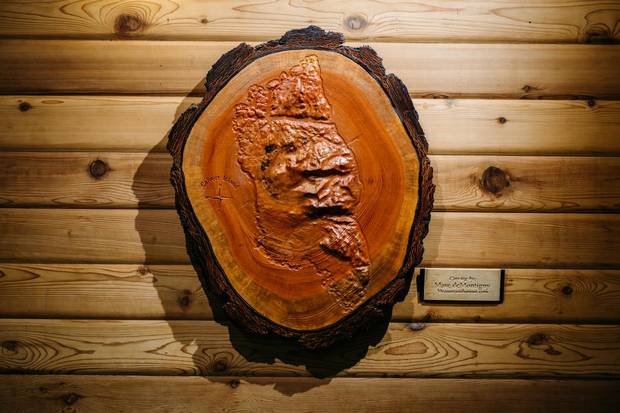
A topographical map of Calvert Island, B.C., where the Hakai Institute is located, hangs in the Hakai lobby.
Jackie Dives
Archeologists have found this stretch of Canada's coast line uniquely rich in history, with evidence of occupation going back thousands of years.
In very recent history, the story of Rivers Inlet is one of a pivotal resource brought to the edge of collapse. Rivers Inlet was home to a dozen or more commercial canneries that processed the abundant salmon runs – until they almost dried up. The last cannery closed in 1968, and the commercial fishery was shut down in 1987.
In
Wuikinuxv, the community raised funds privately to build the $1.2-million salmon hatchery, which is now in its first full year of operation, preserving the genetic diversity of this very special run. The Chinook from the Wannock River are renowned for their size, and but visitors who come for the sport fishing are encouraged to catch and release.
The community shared an ocean harvest with their guests – Sockeye smoked on the cedar fire burning at the centre of the Big House, along with oolichan, halibut, Dungeness crab, herring roe on kelp. The bounty is inextricably linked to the health of the people who live here.
Prior to European contact, there were an estimated 10,000 Wuikinuxv on the coast. Today, there are only two or three people who speak their Wuikkala language fluently. But carvers, dancers and storytellers are regrouping, and with the creation of new job opportunities – including a run-of-river hydro-electric project, now under construction, which will help the community off diesel generators – people are coming home from the cities.
Hereditary Chief Ted Walkus brought visitors up the Wannock River to see the Chinook heading upstream to spawn. He has been a fishing guide for 47 years, and has been a driving force behind the catch-and-release ethic.
"My family has always looked after these fish," he said.
He says overfishing and logging around fish-bearing waterways helped contribute to the collapse. But he notes there are other causes too, pointing to a seal in the river. "They don't eat lettuce." The Wuikinuxv used to eat seals, but that hunt has fallen out of favour and the seal population is rising. "It's easier to order a chicken now," he said.
Mr. Walkus believes climate change is playing a role as well. Glacial melt is occurring earlier in the year. He cites some of the work done by Brian Hunt, the chief scientist on the C3 expedition, who spent three years in Rivers Inlet studying the impact climate change has had on the life cycle of plankton – the food source that juvenile salmon rely on before they make their journey into the ocean.
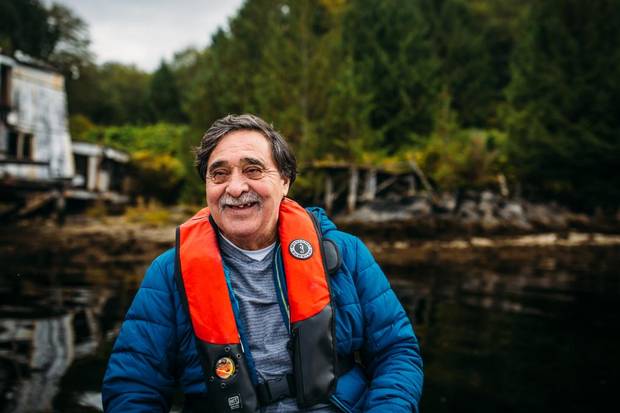
Harvey Humchitt stands near an abandoned cannery in Namu, B.C., where he lived and worked as a child.
Jackie Dives
To witness a physical monument to unsustainability, the Polar Prince put into Namu. Crew members – a mix of artists, musicians, scientists, Indigenous elders and educators who have signed up to experience the coast and meet the people who live there – followed by Heiltsuk hereditary chief Harvey Humchitt for a tour of his childhood home.
Namu is a ghost town now, but Mr. Humchitt, 69, remembers it as a vibrant community of 2,500, with its own power plant and a bowling alley.
"It was a great place to grow up," he says, his boots crunching on broken glass scattered across the linoleum floor of the company store. The shelves are still partly stocked with cans of MJB coffee and pulp fiction books. In defiance of the decay, someone has installed bird nest boxes around the site to encourage at least one kind of resettlement.
Mr. Humchitt's first job, at the age of 16, was working in the local cannery, which could process 150,000 salmon in a single day. When the runs no longer supported that scale of production, the site closed. Now the abandoned plant in the middle of the Great Bear Rainforest represents an environmental threat: In addition to the creosote-soaked wood structure and asbestos concerns, there are 140 fuel barrels rusting away inside a warehouse on the pier.
The Heiltsuk are pressing the provincial government to help tackle the mess on what was once an old village site. "We have evidence that we have lived here for 14,000 years, but look at what has been done in 40 or 50 years," Mr. Humchitt said, looking around the ruins. "It's overwhelming. So much work to be done."
In the woods just behind the sprawling cannery town, the Heiltsuk have re-interred the ancestral remains of 140 people who were exhumed by archeologists. Mr. Humchitt organized the repatriation. Recounting the moment of bringing home those who died here 2,500-5,000 years ago, he was overcome with emotion. His daughter Megan Humchitt had to finish his story: "For thirty years our ancestors were stored in bankers' boxes. We brought our ancestors home in bentwood boxes, as they were meant to be."
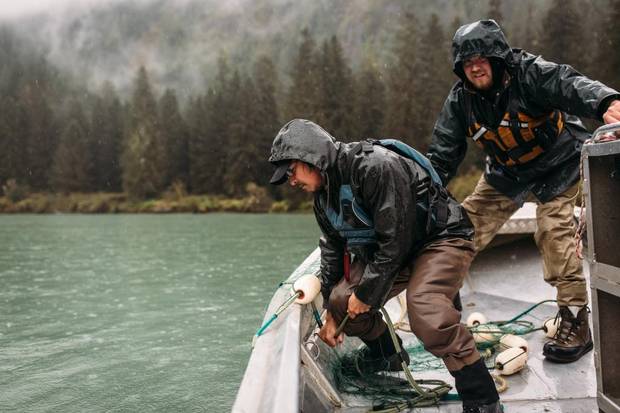
Two salmon fisherman gather their net from the river in River’s Inlet, B.C.
Jackie Dives
The Heiltsuk had lost the tradition of making bentwood boxes – so Mr. Humchitt went to his Haida friends to learn the traditional construction technique of steaming and manipulating a single piece of cedar. The endeavour was supported by the nearby privately funded scientific research institution, the Hakai Institute.
The C3 expedition visited Hakai's headquarters on Calvert Island, where pure science has, by necessity, been informed by the traditional knowledge of the Indigenous history of the region.
Haiki's founder, Eric Peterson, explained to his visitors that he wanted the institute to fill in the gap he saw in scientific research in what is now the protected area of the Great Bear Rainforest. His mission is to understand the coastal ecosystems: "to figure out, in the context of climate change, what's coming at us." Where he chose to establish this research just happens to be in a pocket of the coast that has been a gathering place for thousands of years.
In his first meeting with Heiltsuk leaders a decade ago, where he eagerly laid out his plans, he was bluntly reminded that the original occupants have a great deal of institutional knowledge to offer. "One chief at the table said to me, 'You have 310 years of collective fishery experience here at the table, I hope you respect that.'"
That the institute would end up playing a role in groundbreaking archeology, Mr. Peterson said, came as a surprise to him.
"Our niche is old-fashioned science – exploration and discovery," he said. He was intent on pursuing ocean science, but as he walked along a path across Calvert Island, he described how the archeological significance of this region "insisted" on his attention.
There is an uncanny geological feature that preserved the record of human habitation in the Heiltsuk territory, where the sea levels and shore remained in balance throughout the disruptions of the last Ice Age. Last summer, Hakai-funded researchers found evidence of a village on Triquet Island that dates back 14,5000 years – one of the oldest known settlements in North America – that had been occupied for thousands of years.
The archeological dig uncovered stone tools, charcoal and bone needles. And, buried in the mud, which provided the perfect anaerobic medium, were textiles and a perfectly round wooden ball had been preserved for 8,000 years.
To maintain its reputation as a scientific institute, Hakai does not play an advocacy role, Mr. Peterson said. However its work is enriched by the knowledge of the Indigenous people here, and sometimes guided by their needs. Hakai produced data on herring populations, which the Heiltsuk needed to press for better resource management.
Supporting the work at Koeye camp, where Heiltsuk kids are immersed in cultural lessons as well as scientific exploration, is a natural branch of Hakai's work. Mr. Peterson sees these Heiltsuk youth as the emerging technocrats of their communities – culturally grounded scientists who are committed to restoring and protecting their environments.
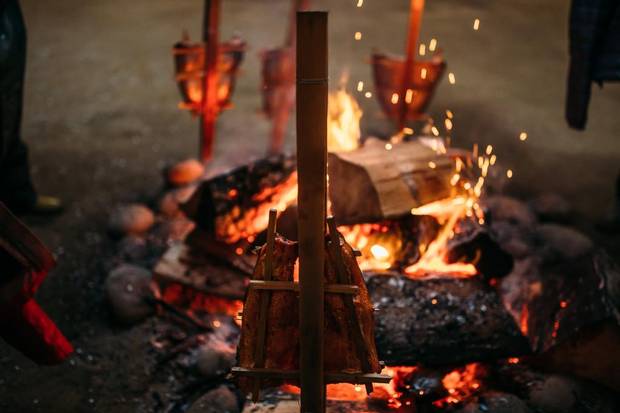
Salmon smokes on the fire in the big house in River’s Inlet, B.C.
Jackie Dives
Reaching the southern edge of the Great Bear Rainforest, the Polar Prince sailed from the God's Pocket marine park to Port Hardy, on the north end of Vancouver Island. The C3 expedition leader, Geoff Green, stood on the bridge of the ship, reflecting on our travels through this remote stretch of Canada's west coast.
The eerie wasteland at Namu will stay with him.
"These are symbols of the destructive force, the irresponsible force that we can be," he said.
All along the west coast, from the Nisga'a, the Haida, the Heiltsuk and more, he said the theme of ecological destruction – and rehabilitation – has been reinforced. "There's a strong lesson I have learned: It is because of the First Nations that this coast is as pristine and protected as it is today."
Justine Hunter spent six days with the Canada C3 Expedition, which concluded its 150-day voyage of circumnavigating Canada's coasts on Oct. 28.
MORE FROM THE GLOBE AND MAIL:
